
|
|

(AD 38-64) Polemo II - AE 211411 viewsPolemo II, 38-64 AD. AE21 (6.56g). Uncertain mint in Armenia, ca 60-64 AD. ΒΑΣΙΛΕΩΣ ΜΕΓ Îœ ΑÎΤΩÎΙΟΥ ΠΟΛΕΜΩÎΟΣ (ΟΣ in ligature), diademed, naked portrait bust of Polemo right within dotted border / ΙΟΥΛΙΑΣ ΜΑΜΜΑΙΑΣ ΒΑΣΙΛΙΣΣΗΣ, diademed, draped portrait bust of Mammaea right within dotted border. About VF. Extremely rare, perhaps the third specimen known.
Originally appointed king of Pontus by Caligula in 38 AD, Polemo made a career dependent on Roman politics. When he was deprived of his (nominal) rule of Bosporus in favor of a certain Mithradates in 41, Claudius gave him the district of the Cilician city Olba instead. In 64, Polemo got at least a part of Armenia as a reward for assisting Corbulo's campaigns. However, just four years later Nero annexed the kingdom of Pontus, and so Polemo's rule was confined to the city of Olba. The king's consort appearing on this coin was Polemo's second wife. His first marriage was to Berenike, sister of Agrippa II and later consort of Titus. His second wife, Mammaea, given the identity of the names, seems likely to have originated from the same region in Syria as the later Roman empress.
|
|

(AD 38-64) Polemo II - Drachm931 viewsPolemo II, with Tryphanae, ca 38-64 AD. AR Drachm (18mm, 3.11g, 2h). Diademed head of Polemo right / Legend in four lines within diadem. Good Fine, toned.
|
|

(AD 38-64) Polemo II - Drachm787 viewsPolemo II, with Tryphanae, ca 38-64 AD. AR Drachm (19mm, 3.33g, 12h). Struck ca 50s AD. Diademed bust of Polemo right / BACI/ΛICCHC/ TPYΦAI/NHC in four lines; all within diadem with ties at bottom. Good Fine, toned, several cuts on edge. Rare.
|
|

(AD 38-64) Polemo II - Drachm RY141305 viewsPolemo II, with Agrippina Junior(?), 38-64 AD. AR Drachm (3.59g, 1h). Dated RY 14 (51/2 AD). Diademed head of Polemo right / Diademed and draped bust of Agrippina Junior right; IΔ (date) to right. VF, toned, minor hairline flan crack, scratch under tone on reverse. Very rare.
Burnett in RPC I identified the female on these drachms as Antonia Tryphonaea, mother of Polemo II, based on the portrait’s similarity to silver and bronze issues which also bear her name. These drachms, however, have no such identifying legend and from the known regnal dates, were struck during the period AD 49-54. Stylistically, they fit within the series bearing clearly identifiable portraits of Claudius and Nero, as well as two examples, dated AD 55/6 and AD 56/7, with a portrait which Burnett tentatively identified as that of Britannicus. As Polemo owed his installation as king to Agrippina Junior’s brother, Caligula, it is quite possible that Claudius’ marriage to his benefactor’s sister in AD 49 prompted him to begin striking these coins which continued, as evidenced by the regnal dates, during her period of influence at court.
|
|

(AD 38-64) Polemo II - Drachm RY15786 viewsPolemo II, 38/9-64/5 AD, with Claudius. AR Drachm (3.17g). Dated 52/3 AD. BACIΛΕωC ΠΟΛΕΜωÎΟC, diademed head of Polemo II right / Laureate head of Claudius right, ETOYC behind, IE before. Some minor porosity, aEF.
|
|

(AD 38-64) Polemo II - Drachm RY15862 viewsPolemo II, with Claudius, 38-64 AD. AR Drachm (3.41g). Dated RY 15 (52/3 AD). ETOYC / IE, laureate head of Claudius right / ΒΑC/ΙΛΕΩC / ΠΟΛΕΜ/ΩÎΟC in four lines within tied diadem. Good VF, toned. Rare.
|
|

(AD 38-64) Polemo II - Drachm RY18879 viewsPolemo II, with Nero, 38-64 AD. AR Drachm (17mm, 3.91g, 6h). Dated RY 18 of Polemo II (55/6 AD). Diademed head of Polemo right / Laureate head of Nero right; ЄTOYC IH (date) in fields. EF.
|
|

(AD 38-64) Polemo II - Drachm RY19595 viewsPolemo II, 38-63 AD. AR Drachm (3.38g), dated year 19 (56/7 AD). Diademed head of Polemo / ΕΤΟΥC ΙΘ, laureate head of Nero. Toned VF.
|
|

(AD 38-64) Polemo II - Drachm RY19693 viewsPolemo II, 38-64 AD. AR Drachm (17.5mm, 3.15g, 3h). Dated RY 19 (56/7 AD). BACIΛEWC ΠOΛEMWNOC, diademed head of Polemo right / ΕΤΟΥC ΙΘ, laureate head of Nero right. gVF.
|
|

(AD 38-64) Polemo II - Drachm RY19799 viewsPolemo II, with Nero, 38-64 AD. AR Drachm (19mm, 3.66g, 6h). Dated RY 19 (56/7 AD). Diademed head of Polemo II right / Laureate head of Nero right. VF, minor scratches under tone. Brace coll.
|
|

(AD 38-64) Polemo II - Drachm RY20581 viewsPolemo II, with Nero, 37/8-41 AD. AR Drachm (18mm, 3.51g, 6h). Year 20 (57/8 AD). [B]ACIΛEWC ΠOΛEMWNOC, diademed head of Polemo right / ETOYC K, laureate head of Nero right; date in legend. Toned VF, minor porosity, old scrape on Nero's cheek.
|
|

(AD 38-64) Polemo II - Drachm RY20671 viewsPolemo II, with Nero. 37/8-41 AD. AR Drachm (18mm, 3.66g, 6h). Dated RY 20 (57/8 AD). Diademed head of Polemo right / Laureate head of Nero right; date in legend. VF.
|
|

(AD 38-64) Polemo II - Drachm RY20885 viewsPolemo II, with Nero, 54-68 AD. AR Drachm (3.55g, 6h). Uncertain mint in Pontus. Dated RY 20 (57/8 AD). BACILEwC POLEMwNOC, diademed head of Polemo right / ETOYC K, laureate head of Nero right. VF, toned, slight die shift on reverse. Strickhausen coll.
|
|

(BC 8-AD 23) Pythodoris - Drachm776 viewsPythodoris, 8 BC-22/23 AD. AR Drachm (3,56g, 19mm). Uncertain mint. Dated CY 60 (unknown era). Laureate head of Augustus right / BAΣIΛIΣΣA ΠYΘOΔΩPIΣ ETOYΣ Ξ, Capricorn right. Minor scratches on obverse, minor corrosion. Very rare. VF.
|
|

(BC 43-16) Asander - AV Stater821 viewsAsander, as king, ca 43-16 BC. AV Stater (19mm, 7.99g, 11h). Dated RY 27 (21/0 BC). Diademed head right / BAΣIΛEΩΣ AΣANΔPOY, Nike, holding wreath in extended right hand, palm frond in left, standing left on prow left; ZK (date) to inner left. VF, fields smoothed. Very rare. Ex Drewry Coll. (CNG 67, 9/2004, lot 620); Stevenson Coll. (CNG XXVI, 6/1993, lot 78); Sotheby's (5/1984), lot 96.
After defeating Pharnakes II in 47 BC, Asander hoped that Caesar would recognize him as king of Bosporos. Instead, in 46 BC Caesar appointed Mithradates of Pergamon, the illegitimate son of Mithradates VI Eupator and a personal friend. Asander, however, subsequently defeated and killed Mithradates. To support his claim to the throne, Asander married Dynamis, the daughter of Pharnakes II, but for the first four years of his reign, he claimed the title ‘archon’ only, rather than that of ‘basileus.’ The reason for this may be that as Rome had formally recognized the archon Pharnakes II as king, Asander was hoping they would do the same on his behalf – a hope confirmed by Octavian in 43 BC. Consequently, all of Asander’s regnal dates are reckoned from his first year as archon (circa 47/6 BC).
|
|

(BC 63-46) Pharnakes II - AV Stater874 viewsPharnakes II, ca 63-46 BC. AV Stater (19.5mm, 8.19g, 1h). Pantikapaion mint. Dated Bosporan Era 245 (53/2 BC). Diademed head right / BAΣIΛEΩΣ BAΣIΛ-EΩN MEΓAΛOY ΦAPNAKOY, Apollo seated left on lion-footed throne, holding branch in extended right hand, left arm resting on kithara; tripod to left; to right, EMΣ (date) above monogram. EF, slightly weak strike, some die wear. Very rare.
Pharnakes was awarded the Bosporan Kingdom by Pompey, for the betrayal of his father Mithradates VI, King of Pontos. Little is known of his 16-year reign except for its ending. During the Civil War between Pompey and Julius Caesar, Pharnakes tried to recapture his father's former territories in Pontos. He won a victory over Caesar's general, Domitius Calvinus, and ordered Romans in the region castrated or put to the sword. In response, Caesar launched a rapid five day war against Pharnakes in 47 BC, culminating in the battle of Zela. Caesar emerged victorious, prompting him to report back to the Senate with the now famous dictum, "Veni, Vidi, Vici" (I came, I saw, I conquered).
|
|
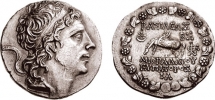
(BC 120-63) Mithdradates VI - Tetradrachm2978 viewsMithradates VI, 120-63 BC. AR Tetradrachm (16.31g, 12h). Pergamon mint. Dated month 11 of 202 BE (August 95 BC). Diademed head right, hair neatly tucked under diadem / ΒΑΣΙΛΕΩΣ ΜΙΘΡΑΔΑΤΟΥ ΕΥΠΑΤΟΡΟΣ, stag grazing left; star and crescent to left, BΣ (year) and monogram to right, IA (month) in exergue; all within Dionysiac wreath of ivy and fruit. Good VF, toned, slight die shift on obverse.
|
|
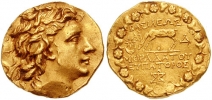
(BC 120-63) Mithradates VI - AV Stater6581 viewsMithradates VI, 120-63 BC. AV Stater (8.46g). Pergamon mint. Dated year 4 of Pergamene Era (86/85 BC); struck during the First Mithradatic War. Diademed head right, hair tousled and flowing freely / Stag grazing left; pellet below, star and crescent to left, D (date) to right, monogram in exergue; all within Dionysiac wreath of ivy and fruit. Good VF, minor scrape in reverse field. Very rare.
Mithradates' career driven by megalomaniacal ambitions leading to murderous assaults upon family and followers and disastrous foreign adventures against superior forces. His idealized portraiture attempts to mimic the gods with its bold staring gaze and unruly, free-flowing hair. The wreath of ivy on the reverse reinforces Mithradates' link with the gods as well as making a connection with the cistaphoric coinage that formerly circulated in the Asian territory he conquered in his first war with Rome in 88 BC, which witnessed the horrific massacre of the Roman citizens of Asia Minor. The stag probably represents the civic center of Ephesos and the mintmark is of Pergamon, all part of the new Pontic kingdom, symbolized by the star and crescent.
|
|

(BC 120-63) Mithradates VI - AV Stater2758 viewsca 120-63 BC. AV Stater (22mm, 8.45g, 12h). Pergamon mint. Dated month 12, year 223 BE (September 74 BC). Diademed head right / Stag grazing left; BAΣIΛEΩΣ above, MIΘPAΔATOY EYΠATOPOΣ in two lines below; to left, star-in-crescent above ΓKΣ (year); two monograms to right, IB (month) in exergue; all within Dionysiac wreath of ivy and fruit. Near EF, a few light marks. Superb high relief portrait, boldly struck and beautifully centered on a broad flan. A unique example, the latest known stater from his reign.
|
|
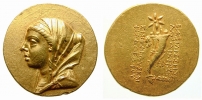
(BC 169-150) Laodike - AV Stater5054 viewsLaodike Epiphanes Philadelphos, wife of Mithradates IV of Pontos, 169-150 BC. AV Stater (8.49g). Diademed and veiled bust of Laodike left / ΒΑΣΙΛΙΣΣΙΣ / ΛΑΟΔΙΚΙΣ / ΕΠΙΦΑÎΟΥΣ ΚΑΙ / ΦΙΛΑΔΕΛΦΟΥ, banded double cornucopiae filled with fruit, six-rayed star above, monogram to right. Unique and unpublished. EF.
This important piece portraits the daughter of Mithradates III of Pontus as a young woman (she is depicted as a more mature woman on Tetradrachms). This Stater has a certain parallel to an also unique Stater of Mithradates IV (see SNG von Aulock 4), which shows the inauguration of the newly wedded brother and sister. The son of Laodike's older brother Pharnakes (successor of Mithradates III), Mithradates V, was too young to succeed his father to the throne. Because of this, Mithradates IV and Laodike, his sister and wife, took over Pontic government around 169 BC. Two more ladies come into question for the portraited woman: the wife of Mithradates V (daughter of Antiochos IV of Syria) and the daughter of Mithradates V of Pontos, who were also called Laodike.
|
|

(BC 169-150) Mithradates IV - Tetradrachm596 viewsMithradates IV, ca 170/169–150 BC. AR Tetradrachm (16.83g), struck in Sinope ca 169 BC. Diademed head right / ΒΑΣΙΛΕΩΣ / ΜΙΘΡΑΔΑΤΟΥ - ΦΙΛΟΠΑΤΟΡΟΣ / ΚΑΙ ΦΙΛΑΔΕΛΦΟΥ, Perseus, naked but for cloak over his shoulders, standing facing and holding gorgoneion and harpa; monogram in lower left field. Extremely rare and among the finest specimens known. An elegant portrait of fine Hellenistic style struck in high relief on a very large flan. Old cabinet tone and aEF. Ex Leu sale 48 (1989), lot 209. From the von Aulock and Salvesen collections.
The reverse of this tetradrachm, which may perhaps predate Mithradates IV’s marriage to his sister, Laodike, depicts the hero Perseus. He appears here, not so much because Mithradates IV wanted to recall the myth of the hero, but because of an old Greek folk etymology that made Perseus an ancestor of the Persians. The Persian Great King Xerxes I (486-465 BC) was already aware of this etymology at the time of his invasion of mainland Greece (480 BC) and tried to use it to convince the Argives to capitulate. The link between Perseus and the Persians was deeply entrenched by 2nd century BC and Mithradates IV, who was himself of Iranian descent, used it to associate the Mithradatic dynasty of Pontus with the greatness of the Achaemenid Persian Empire. The irony of using a Greek hero to advertise a connection to an Iranian empire that was frequently in conflict with the states of Greece is palpable. This irony is further compounded by the otherwise conscious Hellenizing of the obverse type and legend: Mithradates IV wears the diadem of a Hellenistic king rather than the tiara of an Iranian ruler, and the reverse legend is entirely Greek in its use of titles like Philopator (â€Father-lovingâ€) and Philadelphos (â€Brother-lovingâ€). The combination of types and inscriptions on this tetradrachm is wonderfully schizophrenic in the desire to simultaneously tout Mithradates IV as an Iranian scion of the Persian Empire and as a Hellenistic king in emulation of Alexander the Great, the destroyer of that same empire.
|
|

(BC 169-150) Mithradates IV - Tetradrachm732 viewsMithradates IV, ca 170/169-150 BC. AR Tetradrachm (15.99g), struck ca 169-150 BC. Diademed and draped busts of Mithradates IV and Laodice right / ΒΑΣΙΛΕΩ[Σ] / ΜΙΘΡΑΔΑΤΟΥ - ΒΑΣΙΛΙΣΣΗΣ / ΛΑΟΔΙΚΗΣ / ΦΙΛΑΔΕΛΦΩÎ, Zeus, with thunderÂbolt, and Hera standing facing side by side, both holding scepter. Extremely rare. An issue of great fascination with two pleasant Hellenistic portraits, surface somewhat porous, otherwise gVF. Ex NAC sale 2 (1990), lot 173. From the Jameson and Salvesen collections.
Mithradates IV Philopator succeeded his brother, Pharnakes I, as king of Pontus and took great pains to undo the damage to the Pontic kingdom caused by Pharnakes’s conflicts with the neighboring Bithynian and Attalid kingdoms. He supported Attalos II against Prousias II of Bithynia in 154 BC, which also made him a friend of Rome. The friendly relationship that he established with the Romans remained firm until it was shattered irreparably by Mithradates VI Eupator and the Asiatic Vespers of 89/8 BC. Although little else is known about the reign of Mithradates IV, his coins reveal much about the king’s desire to present himself as a Hellenistic monarch equal to the Antigonid, Seleucid, and Ptolemaic kings who could trace their bloodlines back to the generals of Alexander the Great. Despite his Iranian ancestry and possession of a backwater kingdom on the Black Sea, this tetradrachm firmly places him in the tradition of Hellenistic royal superpowers. He wears the diadem, the universal symbol of Hellenistic kingship, and is jugate with the head of his wife, Laodice, who also happened to be his sister. The royal jugate portrait was first pioneered by Ptolemy II Philadelphos for gold coins celebrating the deification of his father and mother as well as of himself and his own sister-wife, Arsinoe II. While marriage between brother and sister had a long tradition among the pharaohs and therefore Ptolemy II and Arsinoe II could be seen as continuing the native Egyptian custom, it was not acceptable in mainstream Greek culture. In an attempt to make his brother-sister marriage more palatable to Greeks, the apologists of Ptolemy II appealed to his divinity, pointing out that Zeus and Hera were also brother and sister. The reverse type of this tetradrachm also seems to make the same argument, depicting the full-length figures of Zeus and Hera as a parallel for the portraits of the king and Laodice on the obverse. The type was presumably aimed at a Greek audience (outside of Pontus?) since brother-sister marriages were not unknown among ancient Iranian elites and would not have required any special explanation - and certainly not one appealing to Greek gods - to the native Iranian population of Pontus. In addition to the aspiration to royal greatness in the footsteps of the Ptolemaic kings expressed by this coin, the treatment of the portraits is remarkable. Unlike the frequent tendency towards idealization in Hellenistic royal coin portraits, the portraits of Mithradates VI and Laodice approach a style that seems to underline the non-Greek ethnicity of the Pontic king and queen. The un-Greek character of the royal portraits are at odds with the other features of the coin that virtually scream Greek royal culture following the Ptolemaic model. As such, this coin brilliantly encapsulates the spirit of the Hellenistic Age, in which many non-Greeks sought to elevate themselves through the adoption of Greek cultural elements.
|
|

(BC 200-169) Pharnakes III - AV Stater2431 viewsPharnakes III, ca 200-169 BC. AV Stater (19.5mm, 8.47g, 12h). Amisos mint. Diademed head right / BAΣIΛEΩΣ ΦAPNAKOY, male figure, wearing flat headdress, holding cornucopia in right hand, vine branch in left, from which a deer, standing right, feeds, on his left; MH monogram to inner right. Good VF, light scuff and edge mark on reverse. Unique. Adams coll.; ex Ley Coll. Lanz 70 (11/1994), lot 81; Tkalec & Rauch (4/1989), lot 105; Leu 22 (5/1979), lot 116; Kastner 4 (11/1973), lot 52.
|
|

(BC 200-169) Pharnakes III - Drachm2559 viewsPharnakes III, ca 200-169 BC. AR Drachm (4.11g, 11h). Diademed and bearded head of Pharnakes right / BAΣIΛEΩΣ ΦAPNAKOY, male figure, wearing petasos, standing facing, cradling cornucopia and kerykeion in his left arm, and holding vine branch in his right hand; star-in-crescent (Pontic royal symbol) to upper left; to lower left, deer standing right, feeding on vine; monogram to right. Good VF, toned, a hint of porosity. Well centered on a broad flan. Splendid hellenistic portrait.
The king in this issue has traditionally been labeled as Pharnakes I, but more recent literature has shown that he is actually the third Pontic king to hold that name. Pharnakes III ascended the throne after the death of his father, Mithridates III, ca 200 BC. Most of his reign was spent attempting to expand the borders of his realm, which, ca 181 BC, brought him into conflict with Eumenes II of Pergamon and Ariarathes IV of Cappadocia, who were allied with each other. Each side blamed the other for the aggression, and appealed to Rome to intervene. Hostilities were temporarily halted after the arrival of a Roman delegation, but their failure to resolve the disputes led to renewed warfare. By 179 BC, it was clear that Pharnakes could no longer withstand the combined Pergamene and Cappadocian forces. In exchange for peace, Pharnakes gave up his possessions in Galatia and Paphlagonia, except for the important trading city of Sinope. Little else is known of his reign.
|
|
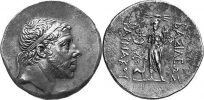
(BC 200-169) Pharnakes III - Tetradrachm2479 viewsca 170 BC. AR Tetradrachm (16.85g, 12h), Sinope mint. Diademed and bearded head of Pharnakes III to right / Pantheistic male deity standing facing, wearing broad petasos, chiton, chlamys and high boots, holding a cornucopiae and a kerykeion with his left hand and feeding a fawn standing right from a vine branch and grapes held in his right; thunderbolt above his head, star within crescent to left. RRR! Toned, probably the finest known tetradrachm of Pharnakes, and with the most realistic of all Hellenistic portraits. Extremely fine.
From the collection of W. Wahler, Numismatic Fine Arts XXV (11/1990), 119, ex Numismatic Fine Arts V (2/1978), 123, and Monnaies et Medailles 47 (11/1972), 475.
|
|
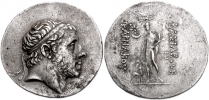
(BC 200-169) Pharnakes III - Tetradrachm1542 viewsPharnakes III, ca 185-170 BC. AR Tetradrachm (35mm, 16.38g, 11h). Diademed head right / Ma(?) standing facing, holding caduceus and cornucopiae, feeding branch to doe standing right below. VF, toned, cleaning scratches under tone. Exceptional Hellenistic portrait. Very rare.
|
|

(BC 220-200) Mithradates III - Drachm1691 viewsMithradates III, ca 220-196/5 BC. AR Drachm (3.96g, 12h). Amaseia or Sinope mint. Struck ca 200 BC. Diademed head right / BAΣIΛEΩΣ MIΘPAΔATOY, Zeus Aëtophoros seated left; to inner left field, star above crescent above monogram. Good VF, toned, granular surfaces, minor edge chips. Extremely rare, the finest of two known, the other in the BN.
Ex Münzen und Medaillen Deutschland 11 (11/2002), lot 676; Bayerische Vereinsbank Münzschätze FPL 11 (4/1976), no. 32.
With the exception of the coinage of Mithradates VI ‘the Great’, the coins of the earlier Pontic kings are very rare, and only a handful of drachms are known. As noted by Mørkholm in EHC, the portraits of these Pontic kings are among the most striking and lifelike in all of Greek royal portrait coinage. Unlike many other series, such as the Ptolemies and Seleukids, the portraits here are not idealized, portraying their subjects “warts and all.†Only some of the coins of the early Greco-Baktrian kings have such lovely die workmanship, but the character displayed in these Pontic portraits is unparalleled.
|
|
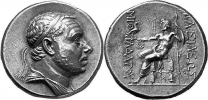
(BC 220-200) Mithradates III - Tetradrachm4143 viewsca 220-196/5 BC. AR Tetradrachm (17.19g, 12h). Amaseia or Sinope mints. Diademed and draped bust to right / Zeus seated left on throne, holding eagle and scepter; star within crescent to left; monogram below throne. Extremely rare. Toned, EF. Gillet Coll., Bank Leu & Munzen und Medaillen (Kunstfreund) (5/1974), 243; Rothschild coll., SWH (5/1900), 304; Carfrae coll., SWH (5/1894), 187; Dupree Coll., Hoffmann (4/1867), 240.
|
|
|
|

|
